|
|
Muley

|
|
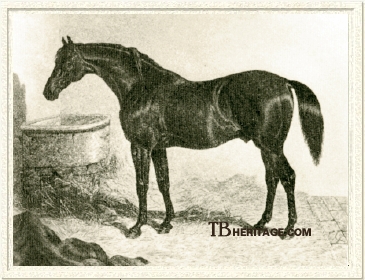 |
|
|
Muley was the son of a mare that won both the Epsom Oaks and Derby, and a stallion that led the sires list in England twice. His owner-breeder was the first "dictator of the turf" and a "perpetual president" of the Jockey Club. Despite this heritage, Muley ran just four times on the turf in one season, winning two handicaps, before retiring to stud. With one brilliant exception, he did nothing as a stallion to merit a place in thoroughbred bloodstock breeding until the age of sixteen, when he came into the hands of a wealthy individual that was an early breeder for the yearling market. Supported by well-bred mares, Muley spent a decade getting good runners and bloodstock that had a profound influence on the thoroughbred.
|
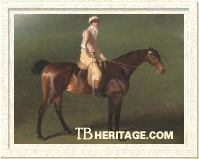
His dam, Derby and Oaks winner Eleanor
| |
Muley's dam, Eleanor (1798, Whisky - Young Giantess by Diomed), a sister and half-sister to a host of good runners and and producers, was a superior weight-carrying racehorse, winning 29 of her 46 races over all distances in five seasons on the turf. She was bred by Sir (Thomas) Charles Bunbury of Great Barton, Suffolk, an M.P. for 43 years who supported Charles James Fox and was an outspoken opponent of slavery. Bunbury became the Steward of the Jockey Club at a time when there was only one, at age twenty-eight, and as "perpetual" president of the Jockey Club, came to yield enormous influence over racing in all of Great Britain, which was brought under the auspices of the Jockey Club during his tenure. He was also a prime mover in developing shorter races for young horses with light weights, and all five classic races in Great Britain were established while he headed the Jockey Club. His horse, Diomed, won the first Derby at Epsom in 1780. |
Eleanor's dam, Young Giantess (1790), had been bred by Bunbury from the Matchem daughter, Giantess, whose Highflyer daughter (1784) produced 1793 Oaks winner Caelia and an unnamed Fidget colt that won the Derby in 1797. Young Giantess, a non-winner in two starts, proved superior to her dam as a producer. In addition to Eleanor, she bred Sorcerer (1796, by Trumpator), a sound, useful racehorse and superior stallion for Bunbury that got seven classic-winning offspring. Her other good ones included Julia (1799, by Whisky, dam of Derby winner Phantom (1808); Cressida (1807, by Whisky), dam of Two Thousand Guineas winner Antar, and Derby winner Priam, an important sire in both England and the U.S.; and a filly by Walton (1808), dam of Two Thousand Guineas winner Nicolo (1820) and of the speedy Langar, whose flying daughter Vulture became the dam of Derby winner and three-time leading sire, Orlando.
Eleanor's first race was at Newmarket at age three, when she won 250 guineas, beating two other three-year-olds. She then won the Epsom Derby, the first filly to do so, beating Fidget, Remnant, and eight others. The next day she beat five fillies to win the Epsom Oaks. At Ascot, carrying 7 lbs. more than the rest of the field due to her classic wins, she was second to Teddy the Grinder in a sweepstakes for three-year-olds. At Newmarket First October she won 700 guineas, beating her sole opponent, Miss Fuery (by Trumpator), and then beat the colt Flambeau (by Skyscraper) in a 200 guineas match at even weights over 1 mile-2 furlongs. At age four she won three races at Newmarket: a 350 guineas sweep beating Penelope and Sister to Gouty, the King's Plate (4 miles), beating five others, and £50 over 1 mile-2 furlongs, beating three others. She lost one race, that year in the spring, beaten by Muley-Moloch (by John Bull) and two others.
In 1803 Eleanor, age five, ran twelve times, and won six, placing second twice, and receiving a forfeit. Her wins included £50 at Ipswich, carrying 9 st.-4 lbs. in two mile heats; the Oxford Gold Cup and £50 in three-mile heats; two £50s at Huntingdon; the King's Plate at Lincoln (three miles). She was second to Dick Andrews in the King's Plate (3 miles) at Newmarket, and second to Penelope in a 375 guineas sweep at Newmarket Second October (4 miles). At age six in 1804, she won eight races and took a walk-over and received a forfeit. Her wins included £50 at Newmarket First Spring, beating seven; £50, carrying 9 st.-2 lbs. at Newmarket Second Spring, beating Quiz, weighted at 8 st.-9 lbs, Duxbury and Gaoler, also carrying less weight; £50 at Ipswich; £50 at Newmarket July; £50 at Chelmsford; £50 at Huntingdon; the gold cup at Newmarket October, beating twelve; and 375 guineas, also at Newmarket October, where she beat Orville and Lignum Vitae. That year she was beaten by Penelope in the three mile King's Plate at Newmarket First Spring, and by Eagle in a 200 guineas match at Newmarket Houghton, and was second to Quiz in the Gold Cup at Brocket Hall, Hertsfordshire.
In her last season, 1805, Eleanor won four races: at Egham she won the Gold Cup, beating Miss Coiner and two others, £50, beating Quiz and three others, and 100 guineas, beating Young Woodpecker. At Newmarket First October she (carrying 9 st.-7 lbs.) beat Czar Peter (age four, carrying 8 st.) in a 200 guineas match. She was second to Bustard (by Buzzard) in a gold cup at Newmarket Second October, with three others in the field, and was second to Stretch in a gold Cup at Newmarket Houghton, with three others in the field. After running unplaced in several races, she was retired from the turf, age seven.
Eleanor bred ten foals for Bunbury, but her best was Muley, her third foal, born in 1810, and the only one she produced to the cover of her old adversary, Orville (by Beningbrough- Evelina by Highflyer), one of the great four-milers of his day, who also ran through age eight, winning all his races in that last season. Orville would become a leading sire in Great Britain twice, in 1817, and in 1823. Of her other foals, two daughters were significant: one an unnamed Dick Andrews mare (1814) produced Picton (1819, by Smolensko), a good racehorse, and Luzborough (1820, by Williamson's Ditto), who went to the U.S. where he was an important stallion in Tennessee. Another daughter, Active (1820, by Partisan), produced Heads or Tails (1831, by Lottery), also sent to the U.S., where her tail-female line was successful through the end of the 19th century.
Muley was a rich dark brown, almost black, colt that grew to 16.1 hands. He was described in 1828 as having "more bone...and greater muscular power, than any thoroughbred stallion in England." Despite his "odd" legs, according to The Druid, he had a fine, sweeping action that he frequently passed on to his offspring.
Muley on the Turf
Muley ran for one season, 1815, at age five. It is not clear if it was his size, a possible injury, his "odd" legs, or something entirely unrelated to the horse himself that delayed his entry onto the turf. He won two races in four starts that year, and then was retired to stud. He began at Newmarket Second Spring, where he won his first race, a £50 handicap sweep over the flat (1 mile-2 furlongs), beating Castrella, Offa's Dyke, Otterington (the 1812 Doncaster St. Leger winner), and eight other horses. He did not run again until Newmarket Second October, wher he was third -- and last -- in a sweep won by Idle Boy, with Cwrw second. At the same meeting, carrying 9 st.-2 lbs. he was second for a plate worth 50 guineas to the future dual Ascot Gold Cup winner Anticipation (age three, carrying 7 st.-2 lbs.), beating Slender Billy (1812 winner of the Doncaster Cup, carrying 9 st.), and seven others. His last race was a handicap plate worth 50 sovereigns at Newmarket Houghton over two miles, which he won (carrying 8 st.-12 lbs.), beating Emily (8 st.-2 lbs.), Caper (7 st.-5 lbs.), and four others. As far as can be judged, he had shown he was a weight-carrier that could win at one and two miles against pretty good competition.
Muley in the Stud
Muley was sold to William Harbord, (2nd) Lord Suffield, as a stallion, and installed at his stud at the Elizabethan-era Blickling Hall, near Aylsham in Norfolk. Blickling had been the country home of Sir Thomas Boleyn, the father of Henry VIII's second wife, Anne Boleyn. Suffield was an M.P. for Luggersball and then for Plympton-Earle, and served as Lord Lieutenant of Norfolk. He married Caroline, the daughter of John Hobart, second Earl of Buckinghamshire, who brought Blickling with her upon their marriage, and retained it after his death in 1821. It is not clear where Muley was between 1822 and 1826, but his foal production dropped precipitously during those years, and most of his racing offspring born in those years -- with one particularly brilliant exception, LEVIATHAN -- were half-breds. In 1826 he was rescued from the road to obscurity by Alexander Nowell, and moved to Underley Hall in Westmoreland, where, even though he was used as a private stallion, he was supported by the wealthy Nowell's good mares, getting three classic winners and many other good runners.
Muley was never a leading sire in Great Britain, but he had a profound influence on the breed, and beyond. His son LEVIATHAN, an excellent racehorse, was sent to the U.S., where he was a leading sire five times; several of Leviathan's daughters were influential in the development of the Standardbred breed. Another son, MORISCO, got Taurus, leading sire in Great Britain in 1841. Muley's St. Leger-winning son, MARGRAVE, also sent to the U.S., was an influential broodmare sire there. MULEY MOLOCH got the "Queen of the Turf," Alice Hawthorn, later the dam of the three-time leading sire Thormanby. DRAYTON got Grand National Steeplechase winner Bourton, and DRAYTON'S SISTER became second dam of Emblem and Emblematic, full sisters that won the Grand National Steeplechase in successive years. GIL BLAS, sent to Australia, got a daughter that was influential in the development of thoroughbreds in New Zealand. ROBIN HOOD was important in the early development of the thoroughbred in Germany, and one of his sons was a founding stallion of the Hanoverian warmblood.
Muley's most significant contribution to the breed was his daughter MARPESSA, the dam of the great broodmare Pocahontas, who produced Stockwell, "the Emperor of Stallions," seven times leading sire in Great Britain, King Tom, twice leading sire, and Rataplan, a good broodmare sire. MORGIANA was the dam of Sheet Anchor. Other Muley daughters were second dams of classic winners and many became tail-female ancestresses of extensive families.
ROBIN HOOD (1818, from Miss Witch, by Sorcerer), a "very rich dark brown with black legs," was bred by Suffield and sold to Baron Biel, "Father of the German Turf," one of many horses the Baron purchased over two decades from Britain. He was installed at the baron's stud at Zierow, near Wismar, where he was a got horses that "take after him very much, and are in very high repute." Some of his Zierow colts the 1820s were the Baron's Black Overseer, "the best horse in Germany," the half-bred Tickler, winner of the Grand Duke Paul Stakes at Dobberan, Colubus, winner of the Frederick Francis Stakes and the Ladies' Stakes at Dobberan, and a number of other good ones. Twelve of his sons entered the Landgestüt Celle in Hannover, and one, Black Comet (from Cinderella by Shuffler), and his sons were founders of an important Hanoverian warmblood line.
Another foal in Muley's first crop was AMY (1818), out of Suffield's homebred mare, Aquilina, by Eagle, the latter considered the best horse of his time at Newmarket. She won some races at Newmarket for the Duke of Dorset at age three, and in his stud bred one foal, Giraffe (1825, by Walton), before dying the next foaling season.

|
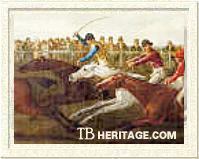
Morisco (behind, jockey with yellow vest) running second in the Claret Stakes
| |
AMY'S brother, MORISCO (1819) won a number of races for Sir John Byng, including the Jockey Club Plate at Newmarket at age five, and a 100 sovereign match against the excellent Cup and match mare Mirandola. In Newmarket's Claret Stakes, he would have won, had he not been deliberately interfered with by other jockeys in the race, which allowed Moses to win. He was another Muley colt picked up by Biel for Germany, and was sent there in 1827, but it was his tail-male descendants that continued the Muley sire line in Great Britain for a couple of generations. Before he left for Germany, he got Taurus (1826, from Katherine by Soothsayer), the leading sire in England in 1841; Zany (1828); Morris Dancer (1826), and some good daughters. |
MORISCO'S daughter Morisca (1826, from Waltz, by Election), was second dam of Prairie Bird (1844, by Touchstone), through which all of Family 1 - r descends. Morisca's sister, Die Freude (1839) bred Cambridgeshire Stakes winner Scherz (1851, by The Provost), and in Germany, Verzug (1854, by Blackdrop), a winner of the Union-Rennen. MORISCO'S daughter Little Fanny (1828, from Fawn (dam of Venison), by Smolensko) won some races as a juvenile before she was sold to Germany. MORISCO'S son Zany (1828) was speedy winner of the Two Year Old Sweepstakes at Newmarket and Newmarket's July Stakes as a juvenile; he was purchased by the Duke of Brunswick, and got some good winners in Germany, including My Lady and Margaretta, both of which won at Brunswick. MORISCO also got Aresena (1828), second dam of Oaks winner Poison, and Zarina (1827), dam of Cesarewitch winner The Cur (1842, by Bran), and his good half-brothers, The Prime Warden (1834) and Envoy (1833). In Germany, MORISCO got Pallas (1844), second dam of 1860 Preis der Diana winner Margarethe.
MORISCO'S son Taurus (1826, properly by Phantom or Morisco), despite being "a rank roarer," won fifteen sweepstakes to age six, almost all of them at Newmarket where "he could almost fly over the T.Y.C. [Two-Year-Old Course]." He proved to be a successful stallion, and headed the sires list in England in 1841, with eleven winners of 37 races. He, too, was sold to Baron Biel, very fond of that Muley blood, for 1,000 guineas after the 1839 season, but was brought back to England in 1842, after his get did so well in 1841, and later was sent back to Germany. In Germany his winners included Union-Rennen winner Minotaurus (1842), and Mehl-Mülhens-Rennen winner Salem (1851).
In England, standing at the Palace Stables at Newmarket, Taurus got Turnus (1846), a winner of Goodwood's Chesterfield Cup and Steward's Cup, and John o' Gaunt (1838), a winner of the Newmarket Stakes, a Queen's Plate at Newmarket and seven other races. Taurus' other winners included Goodwood Stakes winner Franchise (1839), Ascot's Trial Stakes winner Flambeau (1836, also winner of Newmarket's Garden Stakes twice and the Queen's Plate at Newmarket), Chesterfield Stakes winner Minx (1838), Boeotian (1835), a winner of the Column Stakes, the St. James Palace Stakes and the Newmarket Stakes, Ole Bull (1835), winner of Liverpool's Knowsley Dinner Stakes, Io (1836), winner of the Brighton Stakes and Epsom Stakes, Assassin (1837), who took Newmarket's Nursery Stakes and Column Stakes, Buffalo (1838), a winner of Goodwood's Racing Stakes, Oakley (1838), a winner of Newmarket's Column Stakes and six other races, and Wiseacre (1839), who took Goodwood's Ham Stakes and Newmarket's Prendergast Stakes. Io was later second dam of the good Chanticleer filly, Sunbeam (1855), a winner of the Coronation Stakes, Chesterfield cup and Doncaster St. Leger Stakes.
Turnus failed to get a successful sire son, but he did get Liverpool Summer Cup winner Success (1862), and Butterfly (1857), a winner of five races, including the Epsom Oaks and Chester's Palatine Stakes, and second in the Ascot Gold Cup, the Stockton Gold Cup and other good distance races. John o' Gaunt got Bolingbroke (1847), a winner of Doncaster's Don Stakes, and "the lengthy, handsome" Hungerford (1848), who took the Great Yorkshire Handicap at age four, and the Doncaster Cup at age five, but neither of these sons, or any other John o' Gaunts could successfully carry on the sire line.

Muley's daughter MORGIANA (1820, from Miss Stephenson, by Sorcerer), was bred at Blickling and sold as a yearling to Captain E.F. Meynell. To the cover of Lottery, she produced Sheet Anchor, a big, heavy colt that won several races, including York's Sapling Stakes, the Lincoln Gold Cup, and a handicap sweepstakes at Newmarket. The most important sire son of Lottery, in the stud Sheet Anchor got mostly stayers, including Weatherbit (1842), the sire of Derby winner Beadsman, in turn the sire of Pero Gomez and Blue Gown, (both classic winners), and Rosicrucian, an influential broodmare sire.
MONIMIA (1821) was out of a Precipitate mare that was a sister to Petworth, bred by Lord Egremont. The Precipitate mare was purchased by Suffield, producing some good runners by various sires, including the good Cup horse Hocuspocus (1810, by Sorcerer); she also produced Aquilina (1807, by Eagle), the dam of AMY and MORISCO. MONIMIA won the Member's Plate at Abingdon and the Gold Cup at The Hoo, and placed second in the Cups at Chelmsford and Northampton. She later produced Wintonian ((1834, by Camel), a good runner, and two daughters that bred on -- Westeria (1835, by Laurel), and Hester (1832, by Camel), dam of the good juvenile Chatham (1839, by The Colonel), of The Nabob (1849, by The Nob), a useful sire in France, and several good producing daughters that established many long-lived branches of her tail-female family (Family 12 - c). Another MONIMIA daughter, Wedlock (1841, by Sultan Jr.) was a good juvenile that beat Orlando, BUZZ, and three others in the Ascot Produce Stakes, took a walk-over for the Buckenham Stakes at Newmarket October, and won the Rutland Stakes, beating six others at the same meeting; sent to France, she became the dam of Wedding (1856, by Nuncio), a winner of the Prix de la Foret. MONIMIA'S dam also produced several other foals to the cover of Muley, including the winner FRIAR BACON (1818) and MERCANDOTTI (1820), the latter a juvenile winner of two races at Holywell Hunt for Sir Thomas Mostyn, who refused an offer of 500 guineas for her.
Another 1821 filly by Muley, PUCELLE (from the Duke of Rutland's 1814 Oaks winner Medora, by Selim), a half-sister to 1827 Oaks winner Gulnare (1824, by Smolensko), was purchased by the Duke of Grafton. Her wins for him included five subscription purses and handicap sweepstakes at Newmarket in 1825 and four in 1826. In the stud she became second dam of One Thousand Guineas winner The Flea (1846, by Coronation), and third dam of Two Thousand Guineas winner The Ugly Buck (1841, by Venison). Her tail-female line (Family 4 - l), which includes the great Ribot, continues to the present.
Lord Suffield died in August of 1821, and in October his stud was auctioned at Newmarket by Tattersalls, including the pregnant Medora, Aqulina, and a number of young Muley colts and fillies. Muley's 1822 crop was the last bred at Blickling, but most of the foals were actually born elsewhere. MULETEER (1822, from Norah, by John Bull), was bred in the Suffield stud, but was born in the Grosvenor stud, and sold to a Mr. Rogers, for whom he won several sweepstakes at Newmarket and the Frogmore Stakes at Ascot at ages three and four.
Muley's youngsters -- some out of high class mares -- in his first few crops, while useful, were hardly good enough to cause a stampede for the use of Muley as a stallion, and in the mid 1820s he got few foals, most of them out of half-bred mares, for example, Mr. Kempson's black JULIA (1823), a winner of hunters stakes in the Midlands, Mr. Benson's LAVINIA (1823), winner of the Farmers Stakes at Stafford, and TOMMY TICKLE (1824), a gelding that changed hands more than once, winning more than seven races for "horses not thoroughbred" at Croxton Park, Heaton Park, Warwick, Liverpool Leeds, and Ludlow.
However, in 1823, a mare by Windle (a son of the great northern stallion, Beningbrough), the latter a winner of some small races in Yorkshire at age three, dropped a big dark chestnut Muley colt at John Painter's Dean's Hill Stud in Staffordshire. First named Mezereon, and later, due to his towering size and bulk, LEVIATHAN, he would be the first to markedly demonstrate Muley's ability to get good runners.
|
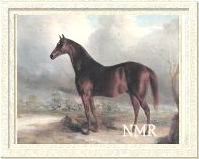
Leviathan. Image ©National Museum of Racing. Used with permission.
| |
LEVIATHAN was purchased by Painter's near neighbor, Thomas Giffard, of Chillington, near Wolverhampton, at the end of his juvenile season. Giffard had another youngster of the same age, Pantaloon, in his stable at the same time, and the two colts campaigned at some of the same meets, although Giffard, recognizing LEVIATHAN'S superiority, would take him farther afield to run. LEVIATHAN was on the turf for three seasons, winning seventeen of his twenty-one starts, including the Gold Cups at Ludlow, Derby, Warwick and Lichfield. Sold for 2,000 guineas to King George IV, he was slated to continue racing, but persistent leg problems finally forced his retirement in 1829, and he was sold to the Earl of Chesterfield as a stallion. |
LEVIATHAN got few mares at Chesterfield's stud in the 1830 season, but of those, there were four winners. By then, however, LEVIATHAN had been purchased by James Jackson of Alabama, and was already several years in America. Standing in the Gallatin, Tennessee, stud of Jackson's confederate, George Elliott, he became the first stallion in the U.S. whose get won over $100,000. Extremely popular after his foals began winning at the major southern turf events, he became leading sire five times -- 1837-39, 1843, and 1848 -- and was second five times on the lists. As a southern-based stallion, many of his second and third generation progeny were lost or displaced by the Civil War, which diminished his long-term effect on American bloodstock. He died in 1846. His full-sister, LUCY (1826), was a good juvenile runner for Giffard, winning two races, at Derby and Warwick.
In 1826 Muley and the Castrel son, Bustard, were purchased by Alexander Nowell, who had just finished the construction of a new, sprawling, huge, Jacobethan manor, Underley Hall -- at a cost of £30,000 -- on the site of the old manor near Kirby Lonsdale in Westmoreland. Nowell was a younger son of Ralph Nowell, scion of a long-established Lancashire family, and had been born at Gawthorpe Hall in Lancashire. He served in the Indian army, retiring to Bengal, and returned to England when he received a large inheritance; he served as M.P. for Westmoreland. Three years after Muley entered the Underley stud, he was joined by the Whalebone son, Longwaist, a good performer Nowell had purchased at the forced sale of the stud and racing stables of the notorious Jack Mytton. Supported by Nowell's wealth, which secured some very good mares, the second half of Muley's stud career was far superior to his first, despite serving as a private stallion at Underley. It was during this time that he got his three classic winners and other good runners. Nowell, an early adopter of the idea of breeding for the yearling market, was so successful at it that his operation was referred to as "the famed Underley stud." His yearlings were sold annually at the Doncaster sales and at Underley, where Muley youngsters brought good prices, averaging 300 guineas.
|
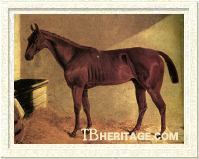
Margrave
| |
MARGRAVE (1829) was the first big winner that came from Underley. He was out of an Election mare (the dam of Chatham) bred at Hampton Court and purchased by Nowell in 1823. He was a big, plain --"ugly looking" was a term used -- dark chestnut colt purchased by Mr. Wreford for whom he won three races (including a walk-over), and placing second in four starts as a juvenile. Sold to former champion boxer John Gully, at age three he won the Doncaster St. Leger and Gascoigne Stakes and the Grand Duke Michael Stakes at Newmarket in six starts. The next season he failed to place in his only start, the Claret Stakes, and was retired from the turf. |
MARGRAVE went to stud at Bishop Burton stud, near Beverley in Yorkshire, and covered mares for two seasons, getting some half-dozen good winners, but by the time they hit the turf, he had been sold to the U.S. horse importers Merrit & Co., and sent to Virginia. Through an English-bred daughter MARGRAVE was dam's sire of Sir Tatton Sykes, winner of the Two Thousand Guineas and Doncaster St. Leger.
In America MARGRAVE got youngsters noted for their speed, and broodmare daughters that established influential female families. His most notable runner was his son Brown Dick (1850, from Fanny King, by Glencoe), a handsome horse that specialized in three-mile races, and set a record at that distance that stood for nine years. He was MARGRAVE'S best sire son, surviving the Civil War, and got some good runners and producing daughters. MARGRAVE'S American daughters included Fanny G. (1845, from Lancess by Lance), a good three-miler that also won at shorter distances, including a famous mile heat race run in 1850, where she lowered the American mile record. She produced Endorser, and several daughters that bred on. Other influential MARGRAVE daughters included: Eleanor Margrave (1846, from Fanny Wright, by Silverheels) and her sister, Emma Wright (1845), the latter second dam of the stallion Monday (sire of Joe Hooker, Mollie McCarty, and other good winners); Margaret Hunter (1845, from Mary Hunt, by Bertrand), whose successful tail-female line included Aristides (1872, by Leamington, winner of the Withers Stakes, Jerome Handicap, Kentucky Derby); and other daughters woven into the pedigrees of famous American runners. Margrave's daughters also were influential in the development of American trotting horses (Standardbreds).
MARGRAVE'S dam, by Election, who had been picked up by Nowell at the Hampton Court sale of King George IV's stud, bred a chestnut filly by Comus (1824) that also went into the Underley stud. There she bred five foals by Muley, including DICK (1833) and RACHEL (1834). DICK, sold to Sir Robert Bukleley, won a number of races, including the Gold Cup at Newton, a handicap sweepstakes at Chester (1-3/4 miles), and the Knutsford Gold Cup (two miles). RACHEL'S win for her owner George Cook included the Tankersville Stakes at Shrewsbury (two miles).
Another 1829 Muley foal was SALUTE (1829, out of Dulcamera, by Waxy). She was a half-sister to Orville's best racing daughter, Souvenir (1824), and to Manchester Cup winner Vestment (1831, by Longwaist). She was bred at Underley and sold to Mr. Dilly as a yearling, afterwards racing in the name of trainer Sam Day. Her wins at age three included the 2-1/2 mile County Plate at Bedford, beating four others, a walk-over for Newmarket's Trial Stakes, and a sweep at Newmarket October; she also placed second to MARGRAVE in the Grand Duke Michael Stakes at Newmarket Houghton. Her tail-female line bred on into the present, with a number of good stakes winners and classic winners, many in France.
Muley's 1830 crop included three good horses: VESPA, MARPESSA, and MULEY MOLOCH.
|
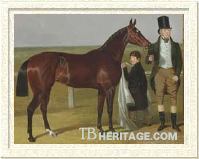
Vespa
| |
VESPA (1830), Muley's second classic winner, was out of Miss Wasp, by Waxy, who had produced Two Thousand Guineas winner Manfred (1814, by Election). She was bred at Underley and purchased by Sir Mark Wood. A small, "tidy" mare, she ran once as a juvenile, in Newmarket's Clearwell Stakes in October, won by Clearwell (winner the next year of the Two Thousand Guineas), with Nonsense (winner the next year of the Grand Duke Michael Stakes) second and Cactus third, and twelve other really good juveniles in the field, including the future One Thousand Guineas winner Tarantella, the good future Cup mare Dirce, the future Newmarket Derby and Oaks winner Octave, and MARPESSA (winner of the Nursery Stakes at Newmarket that year).
|
| At age three VESPA was third to Taratella and Falernia in the One Thousand Guineas, with five others in the field. At Epsom, in a slow race, she won the Oaks by half a neck, beating Octave, with Revelry a poor third and the rest of the good field of fifteen fillies, including Tarantella, trailing behind. At Newmarket October she was beaten in a 200 sovereign match by Muley's daughter MARPESSA (1830), and two weeks later at Newmarket was fourth to Revelry in a handicap sweepstakes. The next year, age four, she won the Oatlands at Newmarket Craven by two lengths, beating Trustee and five others. At Newmarket Spring she won the King's Plate for mares, beating Chantilly and Revelry, and at Newmarket Second Spring she walked-over for the Jockey Club Plate. At Chelmsford in July, she won the King's Guineas, and after that ran once more without placing and was retired from the turf. She was sold to Hungary, but there is no record of any useful produce from her.
|
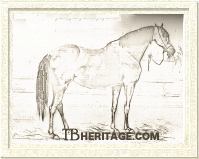
Marpessa
| |
MARPESSA (1830), bred at Underley, was out of Clare, by Marmion. Racing for trainer John Forth, she won Newmarket's Nursery Stakes as a juvenile. At age three she took Goodwood's Racing Stakes and beat VESPA in a 200 guineas match at Newmarket October. The next year she was second to Rockingham in the Brighton Gold Cup. She went into the Royal Stud at Hampton Court and was bred to Glencoe in 1836. When King William IV died in 1837, and the Hampton Stud dispersed, MARPESSA and her first foal, later named Pocahontas, were purchased by Lord Stradbroke for 230 guineas. Through Pocahontas and other daughters, MARPESSA left an an incalcuable mark -- for good and ill -- on the breed. |
Stradbroke sold Pocahontas as a yearling for 62 guineas to gambler John Greatrex, a confederate of trainer John Forth's, but MARPESSA remained in the Stradbroke stud, producing nine more foals, until she was shot in 1848. Pocahontas ran without winning through age five, but she had raced in high-class company and was compromised in her efforts by a tendency to roar, an affliction MARPESSA may also have carried, and seen periodically in her descendants. In the stud of John Theobold, however, this small (14.3 hands) mare became famous in her own time by producing the great stallion, Stockwell (seven times leading sire in Great Britain), his staying brother Rataplan, and half-brother, King Tom, who was twice leading sire in Great Britain. She also bred several daughters that were good producers and influential in the development of thoroughbred bloodstock.
MARPESSA's other offspring included Evenus (1840, by Alpheus), a winner of the Cambridgeshire Stakes and Ascot's Royal Hunt Cup; Two Thousand Guineas and St. James' Palace Stakes winner Idas (1842, by Liverpool); and The Boardingschool Miss (1841, by Plenipotentiary), the dam of Rosa Boneur (1854, by Touchstone), a winner of the Royal Hunt Cup, and several other winners. Several tail-female branches extend from The Boardingschool Miss, and include such horses as the dual classic winner Mysterious (1970) and her half-brother, J.O. Tobin (1974), and Grand Prix de Paris winner Galloper Light (1916).
|
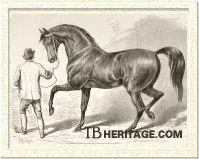
Muley Moloch
| |
MULEY MOLOCH (1830), yet another Underley product, was out of Nancy, by Dick Andrews, who also produced Nowell's stallion Longwaist (1821, by Whalebone), and other siblings to Longwaist, and then a series of foals by Muley, including HOKEE POKEE (1829), MULIANA (1831), BRITTANIA (1834), and RATSBANE (1835). MULEY MOLOCH was a sturdy staying colt that won at one, two and four miles easily, but like most Muleys, he had speed, and beat most of the day's flyers, as well as stayers; of sixteen races in four seasons, he won eleven. Unlike some of Muley's fillies, he was a tall horse, standing 16.3 hands.
|
Most of MULEY MOLOCH'S best runners were bred while he was in the Murton, Yorkshire, stud of Thomas Kirby, a Yorkshire horse dealer and thoroughbred breeder. At the end of the 1841 season Kirby sold him to John Theobold, and the stallion went to Theobald's Stockwell stud near London. His best runner, by far, was Alice Hawthorn, winner of over fifty races in over seventy starts, and later dam of the best colt of his generation, Thormanby (1857), later a leading sire, and several good producing daughters that carried her tail-female line into the present. Another good MULEY MOLOCH daughter, Peggy (1840, from Fanny, by Jerry), a winner of Doncaster's Park Hill Stakes and a good Cup mare, produced Epsom Derby winner Musjid (1856, by Newminster). MULEY MOLOCH'S best son was Galaor (1838, from Darioletta by Amadis), a winner of the Manchester Cup, and sire of Heir-of-Linne (1853), a winning stayer that sired Lord of Linne (1864); Lord of Linne became a good stallion in Australia, but he was effectively the last of the MULEY MOLOCH branch of the Muley sire line.
MULEY MOLOCH'S dam, Nancy, bred some other good winners to the cover of Muley. HOKEE POKEE (1829), purchased by Thomas Giffard (owner of LEVIATHAN), won the Rural Stakes at Newmarket Houghton and some other races. RATSBANE (1835) won a number of races for Lord George Bentinck, including the Salisbury City Members Plate (1-3/4 miles), the Rockingham Stakes at Rochester and Chatham (1-1/2 mile heats), and at Devon and Exeter, the Gold Cup and the City Purse (1 mile heats). MULIANA (1831) was in the tail-female line that included Lady Americus (1909) and her sister Americus Girl (1905), the latter dam of Lady Josephine (1912), whose two daughters Lady Juror (1919) and Mumtaz Mahal (1921) did so much to influence the throughbred.
MULEY MOLOCH'S sister, BRITTANIA (1834), was purchased as a yearling at the Doncaster sales for £220 by American Captain William J. Minor and was sent with three other youngsters to New Orleans in November of 1835, arriving after 50 days on ship. She won one, two and three mile heats races for him, including a $1200 purse (3 mile heats) in December at the Metairie Course in New Orleans, beating Cippus in two heats, and two weeks later the $1200 Proprietor's Purse (two mile heats) in four heats, beating three others, on the Eclipse Course at New Orleans.
BRITTANIA was retired to Miner's stud in Ascension Parish, Louisiana after she broke down in training in the fall of 1839. She was a successful broodmare and had an important influence on 19th century bloodstock breeding. She produced top four-mile horses in Verifier -- a winner at all distances that beat the best of his day, including the great Peytona -- and Voucher, a winner at two, three and four miles. Her daughter Veracity, also a good runner, produced La Vraie Reine (by imported Sovereign), an outstanding race mare that won eleven races in succession without losing a single heat; La Vraie Reine died after breaking down in a race in the the fall of 1853. Another BRITANNIA daughter, Verona (by Yorkshire) was second dam of Vera (1880, by King Alfonso), a Kentucky Oaks winner, and of Vallera (1888, by Springbok), winner of the Travers and Kenner Stakes. BRITANNIA'S other tail-female descendants included Crocket (1895, by Linden), another Kentucky Oaks winner; Tristan (1885, by ), who won the Metropolitan Handicap; and, into the 20th century, Hannibal (1916 by Olambala), winner of the Saratoga Special and Travers Stakes, and Tremont Stakes winner Ticket (1914, by Ballot).
In 1830 Muley got an unnamed MULEY MARE (1830), from Rosanne, by Dick Andrews. This filly, a winner of a produce sweepstakes at Ascot for three year olds, bred Lapwing (1837, by Bustard) that later was the dam of Goodwood Stakes winner Maid of Lyme (1843, by Tomboy) and her half-sister, Maid of Newton (1844, by Sir John). Both "Maids" became tail-female ancestresses of extensive Family 19 branches. Roanne's daughter Rosalia (1825, by Walton), also bred an unnamed MULEY MARE (1838), whose family has bred on into the present, and includes the American runner Slewpy (1980, by Seattle Slew).
Another good producer at Underley was Prima Donna (1821, by Soothsayer). She bred seven foals by Muley. MALIBRAN'S (1830) wins included the Bilbury Stakes (two miles) and the Stockbridge Stakes (1-1/2 miles) at Stockbridge, and she was second in Winchester's Hampshire stakes to Cecilia (two miles). She was sold in 1837 to American E.J. Boardman and sent to Alabama. CANTATA (1834) won two races for Edmund Peel at Nottingham, including the Sherwood Stakes, and the Wrottesley Stakes at Wolverhampton. TOM'S (1835) wins included a half-mile sweepstakes at Buxton, and CHARLEY (1836), won the Member's sweepstakes at Chester.
Two of Prima Donna's Muley foals were influential in steeplechase breeding. Her daughter, an unnamed MULEY MARE (1833), produced Miss Batty (1845, by The Hydra), a winner of some races that later bred the two excellent 'chasing sisters, Emblem (1856, winner 1863 Grand National Steeplechase by twenty lengths) and Emblematic (1858, winner 1864 Grand National Steeplechase), both by the weight-carrying Derby winner Teddington.
Prima Donna's son, DRAYTON (1837), bred at Underley and sold as a yearling to Edmund Peel (whose properties included Drayton Manor) never ran on the flat, but was considered by one turf writer as "one of the finest horses ever to look through a bridle." The big, brown horse was in the Peel Bonehill Stud in Staffordshire, where he got superior hunters. One of DRAYTON'S sons, the gelded half-bred Bourton (1843), "fully 16 hand 2 in. high, with immensely long and strong shoulders, and rather knify withers, a strong neck and rather plain head...was a coward on the flat, but his trainer...always held that he was as good as that great horse Defiance, and actually beat him in a trial on the flat at home...owning to his immense length and fine action, any ordinary fence was no obstacle of importance to him, and his fine turn of speed always reduced the racing part of his performance to a certainty." Bourton won a number of steeplechases, including the Grand National of 1854, carrying a 12 lb. impost. DRAYTON is also the first sire listed for Emigrant, the 1857 Grand National Steeplechase winner, but Melbourne is generally considered to be his sire. DRAYTON's daughter, Margaret (1845, from Switch, by Cain), was sold to France, where she became the dam of Nélusco, a winner of the Grand Prix du Prince Impérial (Prix Royal Oak), and other races.
GIL BLAS (1834) was out of Bequest, by Election. At Underley Bequest bred nine successive foals to the cover of Muley, starting in 1828. Sold to Lord Albemarle, GIL BLAS won some races, and took two walk-overs at Ascot for sweepstakes. In the mid-1830s he was imported into New South Wales by Charles Roberts (owner of Gratis, Sir Charles, and some other good stallions), master of the Wallgrove Stud in County Cumberland. GIL BLAS was a useful, but not outstanding stallion in Australia, but he figures as a good broodmare sire in New Zealand, getting Emma (1844), the dam of Canterbury (later New Zealand) Derby Stakes winner Emmeline (1858, by Sleight of Hand, Junior) and of the gelded Scandal (1863, by Traducer), who also won the Canterbury Derby Stakes. Emmeline produced several good winners to the cover of Traducer, including Detractor (1868) a winner of the Canterbury Jockey Club Handicap (later New Zealand Cup, 2 miles), and Hatred (1867) a speedy winner; a sister to Scandal, called No Name (1867, by Traducer) became the tail-female ancestress of many good Australasian winners, up to the present. GIL BLAS also got Pallas (1846), who bred the VRC Oaks winner Palestine (1858, by Indian Warrior).
Bequest's other Muley foals born at Underley included THE MAGNET (1831), winner of a subscription purse at York (2 miles) and other races for the Duke of Cleveland, and second to Spume in the Great Yorkshire Stakes (1-3/4 miles) at York. Her son SNOOZER (1837) was also sold to Australia, in 1841; sold from Victoria to Tasmania in 1842, in the stud he got Mrs. Burt, the taproot mare of Colonial Family C - 11 through her grandaughter, Belhari (1861), who bred thirteen foals in New South Wales, and whose daughters spread her influence throughout Australasia to the present day. Bequest's unnamed daughter, MULEY MARE (1829) became the dam of Manchester Cup winner Trueboy (1840, by Tomboy), and another good runner, Testator (1846, by Inheritor).
Another Muley son was a good stayer: KING OF CLUBS (1834, from Young Mignonette by Bustard), a winner of a number of races, including the Members Plate at Southampton, the Royal Gold Shield at Plymouth, Davenport and Cornwall (3 mile heats), the City Members Plate at Devon and Exeter (2 mile heats), and the Totnes Stakes at Totnes and Bridgetown (2 mile heats).
Muley's son, the chestnut GILBERT GURNEY (1835, from Miss Orville by Pendulum), "with plenty of substance," was a winner in the Midlands who took the Wolverhampton St. Leger, a sweepstakes at Warwick and the Shropshire Stakes (2 miles) at Shrewsbury, among other races. At stud near Old Warden in Bedfordshire for 5 guineas he got The Traverser (1843, from Pandora by Wrangler), who won a match against the speedy Alarm at Newmarket over the Two Year Old Course, and 500 sovereign match against Pyrrhus the First, also at Newmarket. He also got Bird of Paradise (1845, from a half-bred mare by Priam, HB Family 5), a winner of seven races.
|
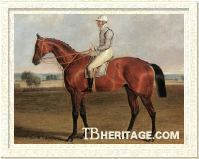
Little Wonder
| |
LITTLE WONDER (1837, from Lacerta, by Zodiac), was bred at Underley and purchased as a yearling by David Robertson of Ladybank, Berwick-on-Tweed, Northumberland. Muley's third classic winner, he was a brilliant bay "little pony," standing 14.3-1/2 hands when grown, and was purchased cheap for 65 guineas at the Doncaster sales. As a juvenile he started twice in the fall at Newmarket, failing to place in a £50 purse for juveniles, and running second in the Nursery Stakes at Newmarket Houghton to Assassin, beating six other juveniles.
|
At age three -- or four, according to some embittered gamblers -- LITTLE WONDER was a surprise winner of the Derby, beating Discord, Launcelot, Assassin, and thirteen others, a length ahead of Launcelot (second) and Discord, with the rest of the field badly distanced. To prove he wasn't a complete fluke he went on to place second to the good Glencoe filly Darkness in the Ascot Stakes at Ascot, with six others in the field. At age four he could not win: he failed to place in Goodwood's Chesterfield Cup, was third to Galanthus and Disclosure in the Great Yorkshire Handicap at Doncaster, with ten others in the field, and was third to Cabrera and Charles XII in the Kelso Gold Cup. In the Border Club Racing Stakes, run just after the Gold Cup at Kelso, he broke down.
Lacerta bred five other Muley foals at Underley. Her son MARVEL (1828), who ran in trainer John Forth's name, won several handicap sweepstakes at Newmarket. He was a very minor sire. Another son, THE LITTLE KNOWN (1836) had a short and unspectacular career, running second to Charles XII in the Roxburgh Gold Cup at Kelso, and failing to place in another race the same day. That one day of racing was his entire time on the turf. He was retired to stud at Lee's Farm near Coldstream on the River Tweed in Scotland, bordering England. There he got some good hunters and some runners. These included My Partner (1859, from Whist by Melbourne), who won a handicap sweep at Doncaster, and Miss Ann (1846, from the unraced Bay Missy, by Bay Middleton), a winner of twelve races, including Goodwood's Chesterfield Cup and the Caledonian Cup at Edinburgh. Miss Ann became the dam of Ascot Gold Cup and Chesterfield Stakes winner Scottish Chief (1861, by Lord of the Isles), a successful sire, particularly of fillies, including Oaks and St. Leger winner Marie Stuart, Yorkshire Oaks and Nassau Stakes winner Maid of Perth, and Mowerina, the dam of Epsom Derby and St. Leger winner Donovan and One Thousand Guineas winner Semolina.
Muley's son, the bay, 16 hands GIBRALTER (1837, from Young Sweet-Pea, by Godolphin), sold as a yearling to General Jonathan Yates, dead-heated with Crucifix for the Criterion Stakes at Newmarket as a juvenile, and went on to win the Newmarket St. Leger, a Queen's Plate at Newmarket, Newmarket's Port Stakes and a 500 sovereign match, also at Newmarket, and ran third in the 1840 Doncaster St. Leger. He wemt to stud at R. Gibson's Castle Bromwich, near Birmingham, but was not an effective stallion.
After a little over a decade as a sucessful stallion at Underley, Muley died in 1837, after covering a few mares at the start of the season.
--Patricia Erigero; thanks to Tim Cox
|
|
|
|

